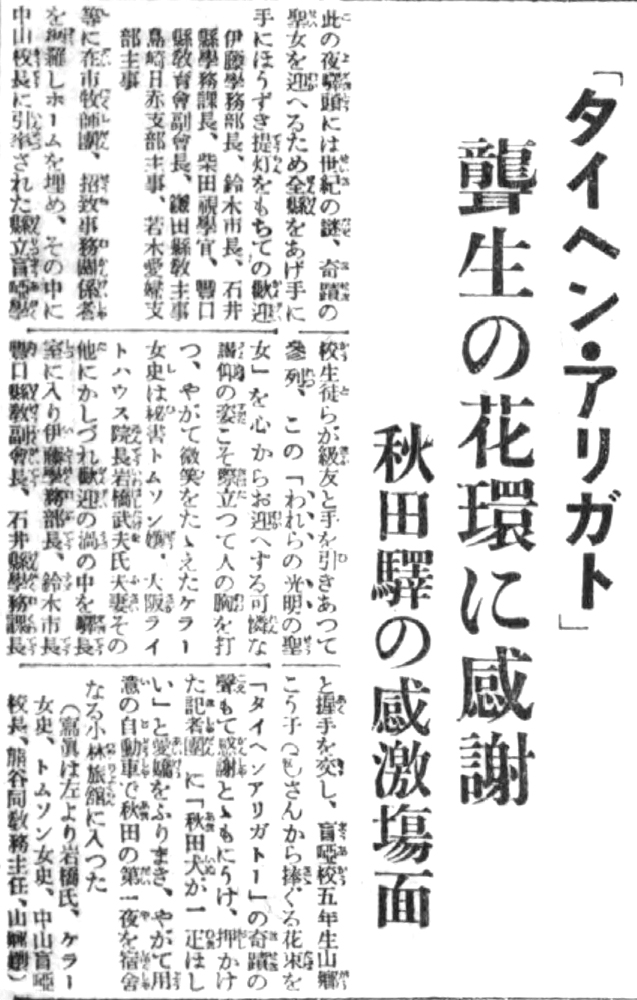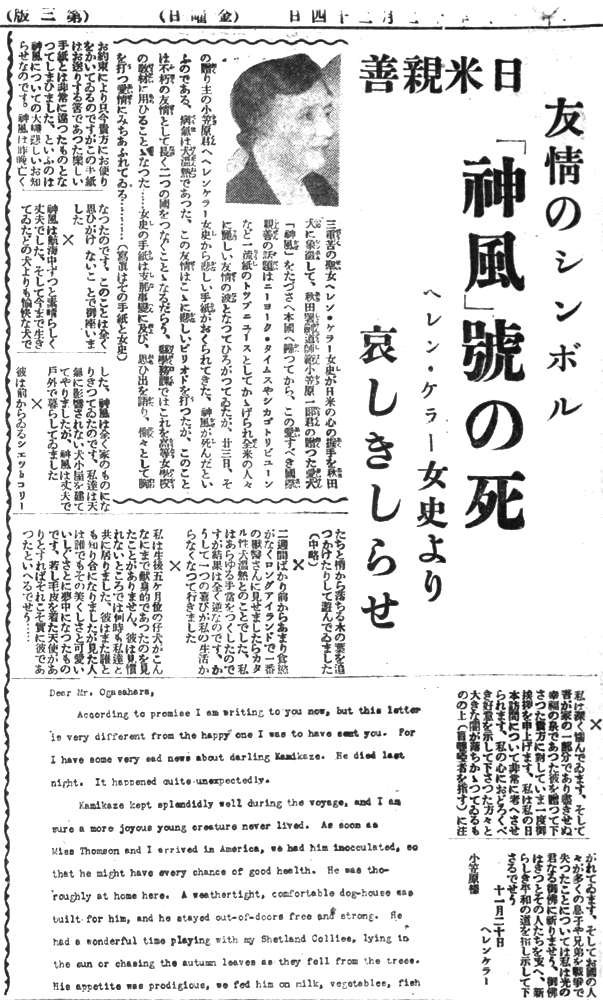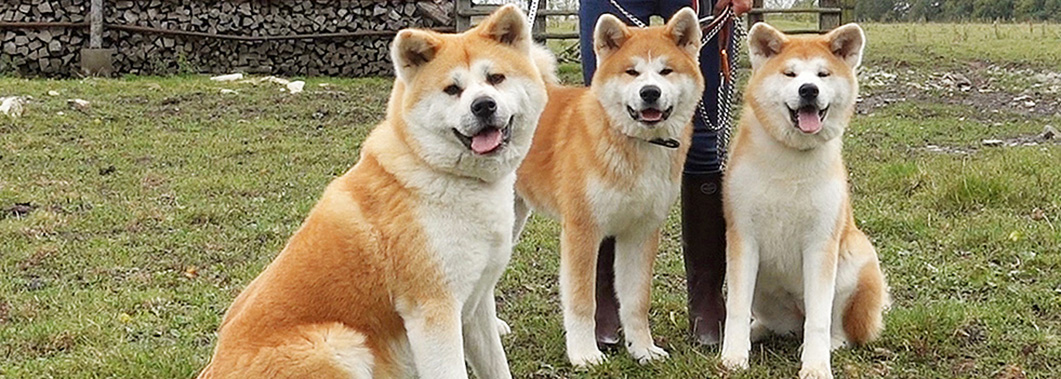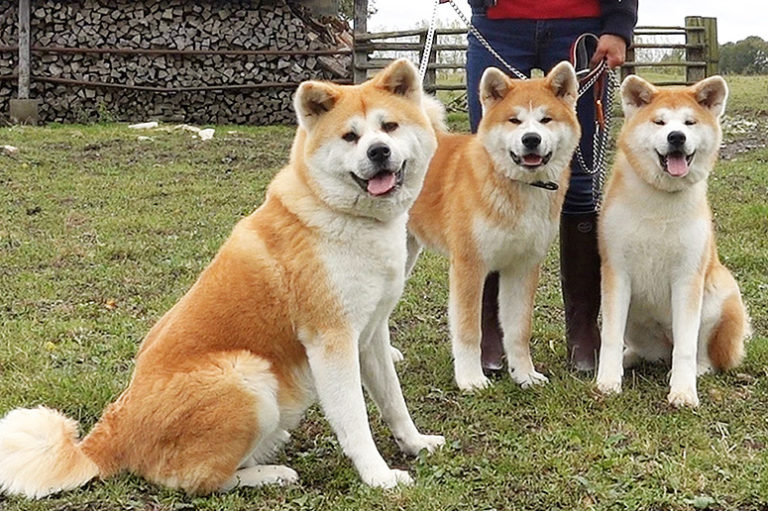U.S. educator, author, and activist Helen Keller (*1), who lost her sight and hearing at the age of two, is renowned for her devotion to people with disabilities. Ms. Keller was also known to be a lover of dogs. Hachiko, the famous faithful Akita dog, especially impressed and fascinated her. In 1937 during Ms. Keller’s three-and-a-half-month tour of Japan, she expressed her desire to have an Akita dog while lecturing in Akita Prefecture. This article will introduce a true story of Ms. Keller and two Akita dogs based on an article from AkitaSakigake Shimpo newspaper written before World War Ⅱ.

“Show sympathy and advocacy for people with disabilities,” Ms. Keller Said During the Interview
Ogasawara Ichiro (* 2), a young police officer and owner of Akita dogs learned of Ms. Keller’s wish to have an Akita dog. Mr. Ogasawara decided to give his 75-day-old “Kamikaze-Go” to Ms. Keller. Mr. Ogasawara later became the Vice-Chairman of the Akita Dog Preservation Society.
Akita dogs are loved all over the world now. Kamikaze was the first Akita dog to travel overseas from Japan. Several news agencies widely reported this episode in the United States as well as in Japan. The morning edition of Akita Sakigake Shimpo, dated June 13, 1937, introduced a report from a journalist who accompanied Keller’s party from Sakata Station in Yamagata Prefecture. The report showed Ms. Keller’s compassion and thoughtfulness toward people with disabilities.

June 13, 1937, morning edition of Akita Sakigake Shimpo:
On the afternoon of June 12th, I welcomed the train at Sakata Station. The “Saint of Three Burdens” (a name given to Helen Keller) finally arrived. Iwahashi Takeo (*3) and his wife introduced Ms. Keller to me. She had blond hair and was wearing a dress with a flower pattern. Turning 57 years old this year, Helen Keller looked warm and merciful. She seemed to be completely tired after lecturing for several days in a row. However, she told me, “Thank you for coming to see me.” It was miraculous for me to experience this exchange of thoughts. I said, “Thank you for visiting us all the way here. I am incredibly pleased to welcome you to Akita. There are more than 3,000 people with disabilities in Akita. Your visit to Akita Prefecture is not only the joy of them but of all the 1 million residents in Akita.”
Ms. Keller’s response to the 1937 journalist:
Though my secretary Miss Thomson caught a cold, somehow, I was motivated to see disabled people in the “Country of Samurai” and show my solace and encouragement to them. I would like to ask Akita’s people for their sympathy and support for those with disabilities like myself. If this can happen, my disabilities will not be in vain. Please give your spiritual devotion to the 3,000 people with disabilities in Akita.
The June 13, 1937, morning edition of Akita Sakigake Shimpo continued:
I talked with her on the train about a 10-year-old boy living in the mountainous area who has the same disabilities as Ms. Keller. She put her hand on Miss Thomson’s lips and understood my story (Tadoma or lip-reading method). Ms. Keller moved her lips, saying, “I’m so sorry to hear that. My heart aches.” I asked, “Ms. Keller, how do you like this trip?” as our interview through Miss Thomson continued. Ms. Keller replied, “Oh, it’s a wonderful experience. Every day I feel a new revelation of beauty, and people’s affection is even more beautiful and nostalgic.”
Around Yuza Station in Yamagata Prefecture, Ms. Keller, Miss Thomson, and Mr. and Mrs. Iwahashi enjoyed eating ekiben (Japanese style portable lunch). Ms. Keller and Miss Thomson communicated with each other by using finger language with their palms. Ms. Keller received a warm welcome at each station and said “goodbye” and “thank you” every time. Ms. Keller’s party arrived at Akita Station at 9:06 pm. Ms. Keller came to Akita City during the season of fresh green.
Ms. Keller Arrives in Akita, Expressed Her Wish to Have an Akita Dog to Reporters
June 13, 1937, the morning edition of Akita Sakigake Shimpo reported Ms. Keller’s arrival in Akita City. People welcomed her with enthusiasm. The 1937 article stated that Ms. Keller voiced her wish to have an Akita dog the night of her arrival. Unfortunately, there were no detailed explanations in the article about how she expressed her wish.

June 13, 1937, morning edition of Akita Sakigake Shimpo:
That night, Akita Station was filled with people from all over the prefecture to welcome the “Miracle Saint.” The Mayor of Akita, executives of the Akita Prefectural Board of Education, JRCS Akita, pastors in Akita City, and people involved in the project waited to welcome Ms. Keller on the platform. Some students from Akita Prefectural School for the Blind also attended holding their hands with each other. The students’ sincere respect for Ms. Keller deeply moved the people.
Eventually, Ms. Keller arrived with a smile, accompanied by Miss Thomson, Mr. Iwahashi, and other party members. They passed through the enthusiastic crowd and shook hands with the Mayor and Akita Prefectural Board of Education executives in the stationmaster’s office. A female student in the fifth grade of the blind school gave Ms. Keller a bouquet, and Ms. Keller gave a heartfelt response, “taihen arigato (thank you so much)” in Japanese. While speaking with reporters, Ms. Keller stated, “I wish to have an Akita dog.” That night, Ms. Keller took a car to a ryokan (traditional Japanese inn) for her first night in Akita.
“As a symbol of international goodwill” – A Young Police Officer Offers an Akita Dog to Ms. Keller
After Ms. Keller’s lecture at the Akita Prefectural Memorial Hall, Akita Sakigake Shimpo reported that Ogasawara Ichiro, a young police officer, offered an Akita dog to Ms. Keller. The episode of Mr. Ogasawara offering Kamikaze, the Akita dog, to Ms. Keller is interesting. Ms. Keller would not accept the dog for free, while Mr. Ogasawara insisted on giving it to her. In the end, the Chief of Police mediated between them, saying there was no need to discuss money for a gift of international goodwill.

June 15, 1937, morning edition of Akita Sakigake Shimpo:
“When I woke up early in the morning, I knew the beautiful greenery of this city. I also knew that it was a city with progressive and kind people.” The world’s saint, Helen Keller, held a lecture on the 13th at Akita Prefectural Memorial Hall with the assistance of her secretary, Miss Thomson. The audience consisted of more than 2,000 people, and Ms. Keller’s lecture brought them to tears, which conveyed the message of love, “giving light to the darkness.”
On July 14th, an international friendship was born between Ms. Keller and Akita’s young police officer, Mr. Ogasawara.
At Ms. Keller’s home in the United States, she has four dogs from four different countries: The United States, Great Britain, Germany, and France. For Ms. Keller, touching the dogs helps her understand the atmosphere of each country.
Akita dogs’ faithfulness impressed Ms. Keller, and so she expressed her wish to have one. Mr. Iwahashi and Miss Thomson tried to conciliate her, saying, “Akita dogs rarely are a pure breed. Even though one was found here luckily, you will then have five dogs if you bring it back to your home country.” However, Ms. Keller’s desire stayed firm. She said, “the dog will connect the people of Japan with the United States.”
“I’ll give her my Akita dog,” said 30-year-old police officer Ogasawara Ichiro from Akita Police Station. Born in Odate, Akita, believed to be the hometown of Akita dogs, the young police officer and kend
ka (practitioner of kendo) offered to give his 75-day-old male puppy “Kamikaze.“
Ms. Keller, who heard this story, said that she could not receive a world-renowned dog for free. On the other hand, Mr. Ogasawara said, “If I had planned to accept money, I would have never offered it from the beginning.” In the end, the Police Chief Takahashi settled on the matter, saying, “The story of money is useless for international goodwill.”
Not knowing his departure from Akita would be very soon, Kamikaze was playful with Mr. Ogasawara.
Mr. Ogasawara said, “Kamikaze is a purebred Akita dog. It is my utmost pleasure and honor to offer this dog as international goodwill, especially to Ms. Keller, who is devoting her life to people worldwide. The dog must be happy, too.”
Ms. Keller’s Letter to Mr. Ogasawara About the Sad News of Kamikaze
About two months after moving to New York with Ms. Keller, Kamikaze died unexpectedly of an infectious disease. The morning edition of Akita Sakigake Shimpo on December 24, 1937 introduced a letter from Ms. Keller to Mr. Ogasawara informing him of the sad news. Ms. Keller said in her letter with a deep sense of loss, “Another joy has gone out of my life. If there ever was an angel in fur, it was Kamikaze.” Ms. Keller also expressed her gratitude to Mr. Ogasawara, saying, “I can only thank you again for a gift which was a precious part of my home, an unfailing source of happiness.”

December 24, 1937, morning edition of Akita Sakigake Shimpo:
Helen Keller, the “Saint of Three Burdens,” returned to her home country with “Kamikaze,” a dog offered by police officer Ogasawara Ichiro of the Akita police station. This beautiful topic of international goodwill made headline news in The New York Times and The Chicago Tribune. However, sad news arrived from Ms. Keller to Mr. Ogasawara on November 23rd. It said Kamikaze died of distemper. Though Kamikaze is not alive now, the friendship between Ms. Keller and Mr. Ogasawara will be a bridge between the two countries for a long time to come. The Akita Prefectural Academic Affairs Division says that high schools will use this friendship story as teaching material.
November 19, 1937, Ms. Keller’s letter to Mr. Ogasawara:
Dear Mr. Ogasawara,
According to promise I am writing to you now, but this letter is very different from the happy one I was to have sent you. For I have some very sad news about darling Kamikaze. He died last night. It happened quite unexpectedly.
Kamikaze kept splendidly well during the voyage, and I am sure a more joyous young creature never lived. As soon as Miss Thomson and I arrived in America, we had him inocculated, so that he might have every chance of good health. He was thoroughly at home here. A weathertight, comfortable dog-house was built for him, and he stayed out-of-doors free and strong. He had a wonderful time playing with my Shetland Collies, lying in the sun or chasing the autumn leaves as they fell from the trees. But things have turned out differently, and another joy has gone out of my life.
I never saw such devotion in a five-months-old puppy. Whenever he was with us in a strange place, and Miss Thomson went out of the room for a few minutes, he would stick close to me. He made friends with everyone, and all who saw him were enthusiastic over his beauty and his adorable ways.
If there ever was an angel in fur, it was Kamikaze. I am so distressed. I can only thank you again for a gift which was a precious part of my home, an unfailing source of happiness.[i]
Akita Dog Goes to Ms. Keller Again
Sasaki Yoshio (*4), Governor of Akita Prefecture, learned of Ms. Keller’s deep sorrow and played a significant role in sending her another Akita dog. Governor Sasaki asked for some advice from now police sergeant Mr. Ogasawara, the giver of Kamikaze. Governor Sasaki knew that Mr. Ogasawara had another three-year-old Akita dog, “Kenzan-Go,” Kamikaze‘s brother. Mr. Ogasawara agreed to give Ms. Keller Kenzan-Go. Mr. Ogasawara was appointed to travel with the dog to the United States as a Japan-US goodwill envoy.

January 13, 1939, morning edition of Akita Sakigake Shimpo:
A symbol of Akita, the Akita dog, was given by a police officer to Helen Keller as a token of goodwill between Japan and the United States. However, Kamikaze suffered from distemper and died in just two months after traveling to the United States. Ms. Keller’s mourning was conveyed to the Japanese Foreign Minister’s secretary by a US newspaper’s senior editor. The secretary then passed on the information to Sasaki Yoshio, Governor of Akita Prefecture.
Governor Sasaki, who heard about Ms. Keller’s tremendous sadness losing Kamikaze, contacted the police sergeant Ogasawara Ichiro. The Governor felt the situation with Ms. Keller’s loss also effected Akita’s pride and wanted to keep the goodwill between Japan and the United States. Mr. Ogasawara had a three-year dog named “Kenzan-Go,” the brother of Kamikaze. Hearing the news about Kamikaze’s passing, Mr. Ogawasara willingly agreed to offer Kenzan-Go to Ms. Keller.
Kenzan-Go is a pure-bred Akita dog. Kend
ka Kanazawa Eijiro was the owner of Kenzan-Go’s parents. Mr. Kanazawa named the puppy “Kenzan-Go” after martial arts and offered him to Mr. Ogasawara.
Now, Mr. Ogasawara is looking after Kenzan-Go with great care, waiting for the day of his departure to the United States. Governor Sasaki, expecting Mr. Ogasarawa to oversee the care of Kenzan-Go, wishes all the best for Kenzan-Go to grow up healthy under Ms. Keller.
“Kenzan-Go is a messenger from the Japanese people.” A letter Arrived from Ms. Keller
Ms. Keller and Kenzan-Go loved their time together in eastern Connecticut, where snowy winters resembled Akita dogs’ hometown. Like Odate City, it was an ideal environment for an Akita dog. Showing her gratitude, Ms. Keller sent a letter to Mr. Ogasawara. In the letter, she said, “I love Kenzan-Go as a messenger from the Japanese people,” which brought joy to Japanese people.

May 16, 1940, morning edition of Akita Sakigake Shimpo:
US newspapers widely reported the Akita dog “Kenzan-Go” crossing the Pacific Ocean as a gift to Helen Keller. A thank-you letter from Ms. Keller arrived at the giver, kend
ka Ogasawara Ichiro of the Akita Prefectural Police Department, on May 15th. Even though war rages in Europe, a moment of light can be found in the dark.
In June of last year, the secretary of the Minister of Foreign Affairs requested Governor Sasaki Yoshio of Akita Prefecture to find an Akita dog to offer Ms. Keller. The Chief of Police, Mr. Morimoto, asked police officer Mr. Ogasawara to help with this request. In August 1937, Mr. Ogasawara presented Ms. Keller, an Akita dog named “Kamikaze,” but Kamikaze died shortly thereafter. After learning about Ms. Keller’s loss, Mr. Ogasawara happily gave Kenzan-Go to continue the goodwill between Japan and the United States.
May 16, 1940, morning edition of Akita Sakigake Shimpo containing Ms. Keller’s letter addressed to Mr. Ogasawara:
Westport, Conn.,
April 1, 1940.
Dear Mr. Ogasawara,
Nearly a year has passed since I had the joy of welcoming Kenzan-go to my home. I wanted to write to you long ago and to send you a photograph of him in all his beauty, but not until recently was it possible to have the picture taken.
You will see that Kenzan-go is as handsome as ever and full of life, but he is infinitely more than that. He has become a splendid protector and companion, and is a precious part of my daily life. He lies beside me all golden in the sun while I write or read. Now and then he rises and lays his noble head on my knee with great affection. He is never so happy as when Miss Thomson and I take him out for a walk.
We have had deep snow-drifts here all winter, and it has been a delight to watch Kenzan-go rolling and leaping over them. Sometimes with a powerful paw he would break the ice in a brook for a drink, then away he would go, following the tracks of a fox or a deer in the snow, but he always came back telling me with nose, ear and tail to play with him.
It touched me greatly when I heard from Mr. Fleisher that you had given up your favorite dog for my sake, and he meant all the more to me. I thank you every time I stroke his beautiful coat or touch his tail waving like a pine bough in the breeze. I love him not only as your dog, but also as a message from the Japanese people whose friendship shines among my brightest memories.
With kindest salutations, and with all good wishes, in which Miss Thomson joins, I am,
Sincerely yours,
Helen Keller[ii]
Helen Keller completed her adventurous life in 1968, 31 years after her first visit to Japan. She was 87 years old. She is now sleeping in peace in the National Cathedral in Washington, DC.
(*1) Helen Keller (1880 – 1968) American author, political activist, and lecturer.Ms. Keller was born in northwestern Alabama. In infancy, she lost both her sight and hearing due to a high fever of unknown causes, which also affected her speaking ability. At the age of 6, she met a tutor Anne Sullivan who became Ms. Keller’s life-long teacher and companion. In 1904, Ms. Keller graduated from Radcliffe College of Harvard University with extraordinary efforts, becoming the first deaf-blind person to earn a bachelor’s degree in the United States. Ms. Keller toured the world, striving for education and welfare for the physically challenged. She was also active in a wide range of political fields, including gender equality, opposing racial discrimination, and anti-war activities. Ms. Keller visited Japan three times in 1937, 1948, and 1955. She died in June 1968.
(* 2) Ogasawara Ichiro Born and raised in Odate City. After graduating Odate Junior High School (currently Odate Homei High School) and Otaru High School of Commerce (now Otaru University of Commerce), he worked for the Metropolitan Police Department and eventually transferred to the Akita Prefectural Police. He was also a kendo master. He served as Chairman of the Akita Kendo Federation, director of the All Japan Kendo Federation, and Vice-Chairman of the Akita Dog Preservation Society.
(*3) Iwahashi Takeo (1898 – 1954) Founder of the social welfare corporation “Nippon Lighthouse Welfare Center for The Blind.” Nippon Lighthouse is a life support group for the visually impaired. Mr. Iwahashi lost his sight at the age of 21 while he was a student at Waseda University. After learning about social welfare activities in the United Kingdom, he established Nippon Lighthouse in 1922 and began printing braille books, lending them to the blind free of charge and offered consultations and lectures. Mr. Iwahashi also contributed to Helen Keller’s invitation to Japan in 1937 and 1948.
(*4) Sasaki Yoshio (1894 – 1949) The 37th Governor of Akita Prefecture (elected by the government with an election system before World War II) from June 24, 1938, to January 11, 1939. During his tenure, he promoted the reclamation project of Lake Tazawa, the deepest lake in Japan. He was born in Miyagi Prefecture.
[i]Keller, Helen. Helen Keller to Ogasawara Ichiro, Akita, Japan, November 19, 1937. Akita Inu Hozonkai (Akita Dog Preservation Society), Odate City, Akita Prefecture, Japan.
[ii]Keller, Helen. Helen Keller to Ogasawara Ichiro, Akita, Japan, April 1, 1940. Akita inu Hozonkai (Akita Dog Preservation Society), Odate City, Akita Prefecture, Japan.








